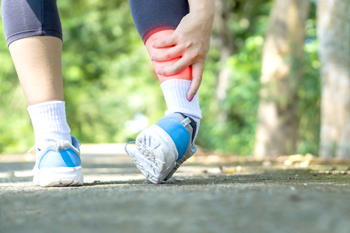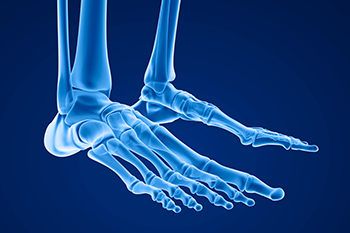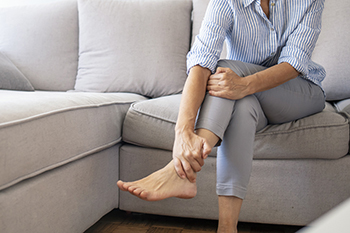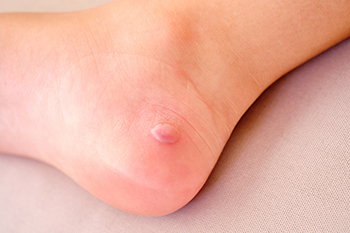Connect With Us
Blog
Items filtered by date: September 2025
Tips to Help Prevent Running Injuries
 Did you know that 80% of running injuries are caused by repetitive stress? Sudden injuries can occur too, such as torn muscles or sprained ankles. Luckily, there are steps that you can take to help prevent running injuries. Before you start your run, it is suggested that you warm up for 5-10 minutes by doing an easy jog or dynamic mobility stretches, like swinging your legs. When you are running, slowly increase the time and distance that you run. If possible, run on a soft surface like grass or sand. These soft surfaces are generally easier on your joints as opposed to running on the pavement. If you do sustain an injury, seek treatment right away and be sure to give your body adequate rest. Running with an injury could make the condition worse or cause new injuries to develop. For more information on how to prevent running injuries, consult with a podiatrist.
Did you know that 80% of running injuries are caused by repetitive stress? Sudden injuries can occur too, such as torn muscles or sprained ankles. Luckily, there are steps that you can take to help prevent running injuries. Before you start your run, it is suggested that you warm up for 5-10 minutes by doing an easy jog or dynamic mobility stretches, like swinging your legs. When you are running, slowly increase the time and distance that you run. If possible, run on a soft surface like grass or sand. These soft surfaces are generally easier on your joints as opposed to running on the pavement. If you do sustain an injury, seek treatment right away and be sure to give your body adequate rest. Running with an injury could make the condition worse or cause new injuries to develop. For more information on how to prevent running injuries, consult with a podiatrist.
Exercising your feet regularly with the proper foot wear is a great way to prevent injuries. If you have any concerns about your feet, contact one of our podiatrists of Whitestone Podiatry PC. Our doctors will treat your foot and ankle needs.
How to Prevent Running Injuries
Many common running injuries are caused by overuse and overtraining. When the back of the kneecap starts wearing out and starts causing pain in your knee, this is commonly referred to as runner’s knee. Runner’s knee is a decrease in strength in your quadriceps and can occur if you’re not wearing properly fitted or supporting shoes. To prevent runner’s knee, focusing on hip strengthening is a good idea, as well as strengthening your quads to keep the kneecaps aligned.
What Are Some Causes of Running Injuries?
- One cause of a common running injury is called iliotibial band syndrome.
- Plantar fasciitis is also another common injury.
- Stress fractures can occur from overtraining, lack of calcium, or even your running style.
Best Ways to Prevent Running Injuries
- Wear footwear that fits properly and suits your running needs.
- Running shoes are the only protective gear that runners have to safeguard them from injury.
- Make a training schedule. Adding strengthening exercises as well as regular stretching can help keep you strong and limber and can lessen the possibility of injuries.
- Stretching keeps muscles limber; this will help you gain better flexibility.
If you have any questions, please feel free to contact our office located in Whitestone, NY . We offer the newest diagnostic and treatment technologies for all your foot care needs.
Plantar Warts Can Be Treated!
What Is Freiberg’s Disease?

Freiberg’s disease is a painful foot condition that affects the metatarsal bones, most often the second metatarsal located near the base of the toes. It occurs when the blood supply to the bone is disrupted, leading to tissue damage and collapse of the bone surface. Causes may include repetitive stress, trauma, or genetic predisposition, and it most often develops in adolescents and young adults. Symptoms include pain in the ball of the foot, swelling, stiffness, and difficulty bearing weight or wearing shoes comfortably. A podiatrist can help by diagnosing the condition, providing orthotics, recommending activity modifications, or discussing surgical options in severe cases. If you have persistent foot pain, it is suggested that you promptly consult a podiatrist who can accurately diagnose the problem and offer effective relief and management solutions.
Some foot conditions may require additional professional care. If you have any concerns, contact one of our podiatrists of Whitestone Podiatry PC. Our doctors can provide the care you need to keep you pain-free and on your feet.
Rare Foot Conditions
The majority of foot conditions are common and can be treated by a podiatrist. Standard diagnostic procedures are generally used to identify specific conditions and treatment can be rendered. A podiatrist also treats rare foot conditions which can be difficult to diagnose and may need extra attention and care.
There are many rare foot conditions that can affect children. Some of these can include:
- Freiberg’s disease
- Kohler’s disease
- Maffucci syndrome
Freiberg’s disease - This can be seen as a deterioration and flattening of a metatarsal bone that exists in the ball of the foot. It typically affects pre-teen and teenage girls, but can affect anyone at any age. Symptoms that can accompany this can be swelling, stiffness, and the patient may limp.
Kohler’s disease - This often targets the bone in the arch of the foot and affects younger boys. It can lead to an interruption of the blood supply which ultimately can lead to bone deterioration. The patient may limp or experience tenderness, swelling, and redness.
Maffucci syndrome - This affects the long bones in a child’s foot leading to the development of abnormal bone lesions. They are benign growths and typically develop in early childhood and the bones may be susceptible to breaking.
A podiatrist can properly diagnose and treat all types of rare foot conditions. If your child is affected by any of these symptoms or conditions, please don’t hesitate to call our office so the correct treatment method can begin.
If you have any questions, please feel free to contact our office located in Whitestone, NY . We offer the newest diagnostic and treatment technologies for all your foot care needs.
Finding Comfort on Arthritic Feet

Arthritis in the feet and ankles can make even simple steps feel difficult. Stiffness may limit motion in the joints, while swelling and tenderness can create ongoing discomfort. As the protective cartilage wears down, bones may rub together and lead to further pain. The changes often affect balance and endurance, making long walks or standing for extended periods of time challenging. Shoes that once felt comfortable may no longer provide enough support, and uneven pressure on the foot can increase fatigue. Walking aids or custom orthotics are sometimes needed to reduce strain and improve stability. Gentle activity, however, often helps keep joints moving and prevents further stiffness. Since arthritis affects each person differently, professional guidance from a podiatrist can make a significant difference. If walking is becoming painful due to arthritis, it is suggested that you visit this type of doctor for effective relief and management tips.
Arthritis can be a difficult condition to live with. If you are seeking treatment, contact one of our podiatrists from Whitestone Podiatry PC. Our doctors can provide the care you need to keep you pain-free and on your feet.
Arthritic Foot Care
Arthritis is a joint disorder that involves the inflammation of different joints in your body, such as those in your feet. Arthritis is often caused by a degenerative joint disease and causes mild to severe pain in all affected areas. In addition to this, swelling and stiffness in the affected joints can also be a common symptom of arthritis.
In many cases, wearing ill-fitting shoes can worsen the effects and pain of arthritis. Wearing shoes that have a lower heel and extra room can help your feet feel more comfortable. In cases of rheumatoid arthritis, the arch in your foot may become problematic. Buying shoes with proper arch support that contour to your feet can help immensely.
Alleviating Arthritic Pain
- Exercises that stretch the foot can prevent further pain and injury and increase mobility
- Most of the pain can be alleviated with anti-inflammatory drugs, heat, and topical medications
- Massages can help temporarily alleviate pain.
It is best to see your doctor for the treatment that is right for your needs and symptoms. Conditions vary, and a podiatrist can help you determine the right method of care for your feet.
If you have any questions please feel free to contact our office located in Whitestone, NY . We offer the newest diagnostic tools and technology to treat your foot and ankle needs.
Understanding Diabetic Blisters on the Feet

Diabetic blisters are a rare but serious skin complication that can occur in people with diabetes. These blisters often appear suddenly, usually on the feet or toes, and may resemble burn blisters. They are typically painless, filled with clear fluid, and may be surrounded by slightly red or swollen skin. Poor circulation, nerve damage, and uncontrolled blood sugar levels are common causes. While they may heal on their own, diabetic blisters are a warning sign of underlying issues and can lead to infections, if not cared for properly. A podiatrist can diagnose diabetic blisters through a physical exam and an evaluation of medical history. Treatment focuses on protecting the area, preventing infection, and management of blood sugar levels. In some cases, topical medications or dressings may be applied. If you notice unexplained blisters on your feet, especially without injury, it is suggested that you schedule an appointment with a podiatrist for proper care and monitoring.
Blisters are prone to making everyday activities extremely uncomfortable. If your feet are hurting, contact one of our podiatrists of Whitestone Podiatry PC. Our doctors can provide the care you need to keep you pain-free and on your feet.
Foot Blisters
Foot blisters develop as a result of constantly wearing tight or ill-fitting footwear. This happens due to the constant rubbing from the shoe, which can often lead to pain.
What Are Foot Blisters?
A foot blister is a small fluid-filled pocket that forms on the upper-most layer of the skin. Blisters are filled with clear fluid and can lead to blood drainage or pus if the area becomes infected.
How Do Blisters Form?
Blisters on the feet are often the result of constant friction of skin and material, usually by shoe rubbing. Walking in sandals, boots, or shoes that don’t fit properly for long periods of time can result in a blister. Having consistent foot moisture and humidity can easily lead to blister formation.
Prevention & Treatment
It is important to properly care for the affected area in order to prevent infection and ease the pain. Do not lance the blister and use a Band-Aid to provide pain relief. Also, be sure to keep your feet dry and wear proper fitting shoes. If you see blood or pus in a blister, seek assistance from a podiatrist.
If you have any questions, please feel free to contact our office located in Whitestone, NY . We offer the newest diagnostic and treatment technologies for all your foot care needs.
How Yoga Poses Strengthen and Stabilize the Feet

Yoga is an effective way to build strength and stability in the feet while improving overall balance. Certain poses engage the small muscles of the feet and ankles, helping to support proper alignment and reduce the risk of injury. Regular practice can increase flexibility, enhance circulation, and relieve tension that often builds up from daily activities or improper footwear. Stronger feet contribute to better posture and movement, which benefits the entire body. A podiatrist can assess foot function, address pain, and recommend specific exercises or treatments to complement yoga practice. If you have any type of foot pain, or want to improve foot health and stability, it is suggested that you consult a podiatrist who can treat various foot conditions.
Why Stretching Is Important for Your Feet
Stretching the feet is a great way to prevent injuries. If you have any concerns with your feet consult with one of our podiatrists from Whitestone Podiatry PC. Our doctors will assess your condition and provide you with quality foot and ankle treatment.
Stretching the Feet
Stretching the muscles in the foot is an important part in any physical activity. Feet that are tight can lead to less flexibility and make you more prone to injury. One of the most common forms of foot pain, plantar fasciitis, can be stretched out to help ease the pain. Stretching can not only ease pain from plantar fasciitis but also prevent it as well. However, it is important to see a podiatrist first to determine if stretching is right for you. Podiatrists can also recommend other ways to stretch your feet. Once you know whether stretching is right for you, here are some excellent stretches you can do.
- Using a foam roller or any cylindrical object (a water bottle or soda can will do), roll the object under your foot back and forth. You should also exert pressure on the object. Be sure to do this to both feet for a minute. Do this exercise three times each.
- Similar to the previous exercise, take a ball, such as a tennis ball, and roll it under your foot while seated and exert pressure on it.
- Grab a resistance band or towel and take a seat. If you are using a towel, fold it length wise. Next put either one between the ball of your foot and heel and pull with both hands on each side towards you. Hold this for 15 seconds and then switch feet. Do this three times for each foot.
- Finally hold your big toe while crossing one leg over the other. Pull the toe towards you and hold for 15 seconds. Once again do this three times per foot.
It is best to go easy when first stretching your foot and work your way up. If your foot starts hurting, stop exercising to ice and rest the foot. It is advised that you then see a podiatrist for help.
If you have any questions please contact our office located in Whitestone, NY . We offer the newest diagnostic and treatment technologies for all your foot and ankle needs.

